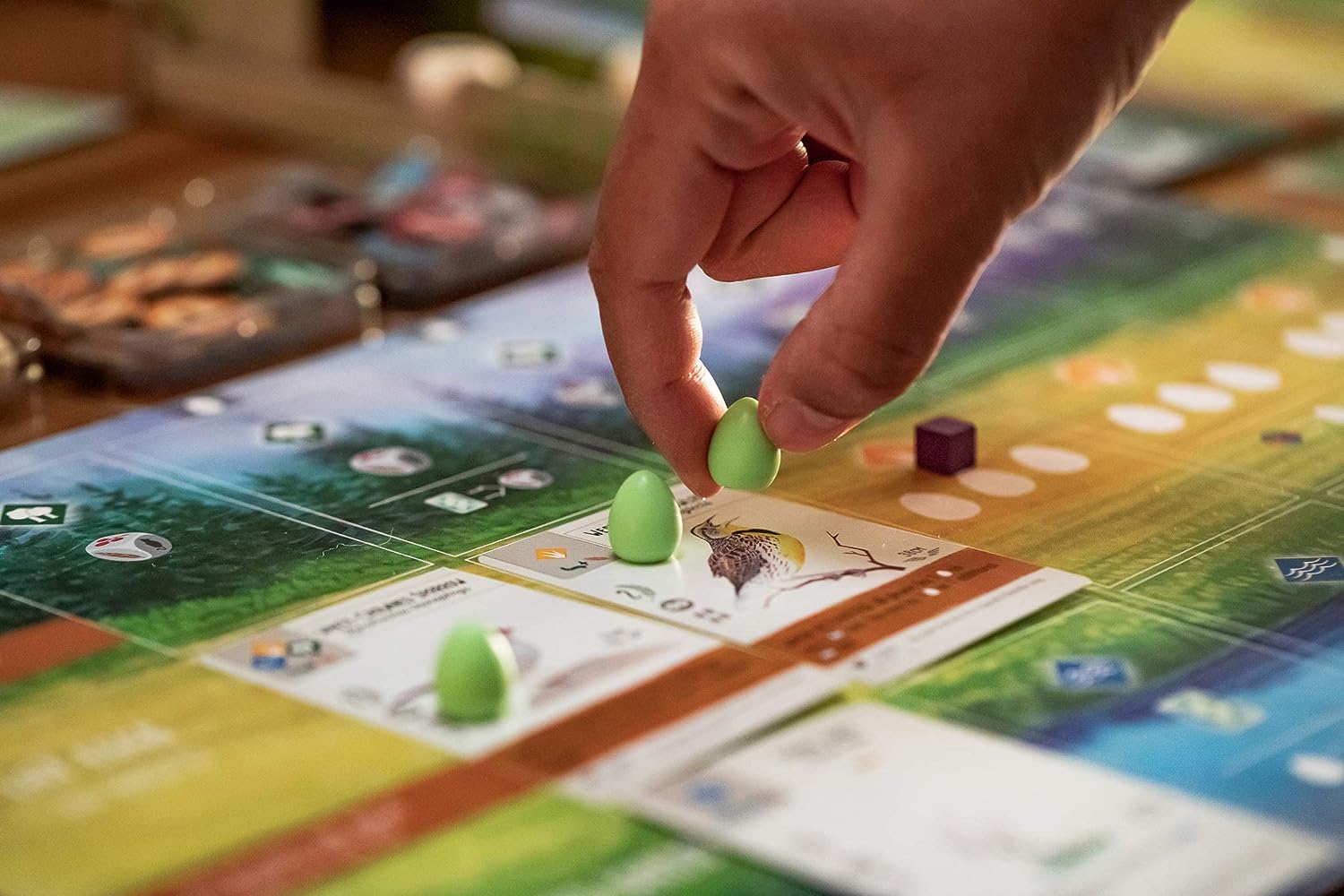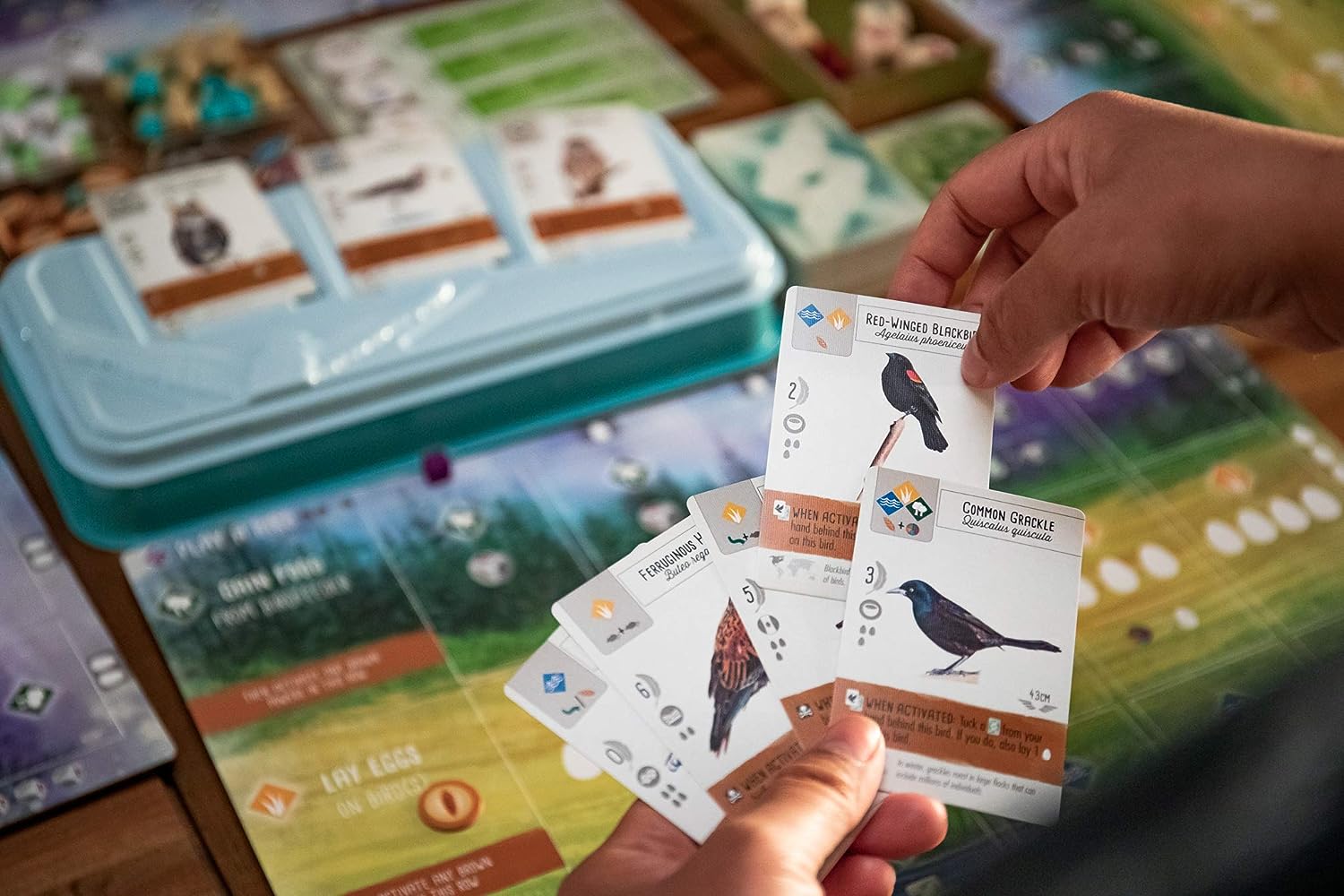Imagine a board game where you’re not just rolling dice or moving pieces; you’re building a bird sanctuary that’s so awesome that even makes Disney’s Enchanted Tiki Room jealous.
The game lets you be the bird whisperer you never knew you were – you’re not just spotting birds; you’re curating the ultimate bird party.
Each bird card is like a VIP guest with its own unique abilities. Lay eggs, hatch chicks, and turn your little feathery companions into a dominating force in different habitats. It’s like playing Mother Nature but with more feathers and fewer allergies.
So, gather your bird squad, prepare for some avian rivalry, and let the feathers fly in this game that’s all about becoming the ultimate bird boss.
What’s included in Wingspan

- Bird cards (170 cards across five types)
- Player boards (with spaces allocated for bird cards, food tokens, eggs, and action cubes)
- Action cubes (in various colors)
- Dice tower (a tower-shaped device for drawing bird cards)
- Dice (used with the dice tower)
- Goal tiles (various objectives for each round)
- Food tokens (representing different types of food)
- Egg tokens (for tracking the number of eggs on bird cards)
- First-player token (a wooden birdhouse-shaped token)
- Scorepad (for keeping track of Victory Points)
How to play Wingspan for 2-5 players
Wingspan is a popular board game designed by Elizabeth Hargrave and published by Stonemaier Games. It is a beautifully illustrated game where players take on the roles of bird enthusiasts trying to attract and care for different bird species in their wildlife preserves. Here’s how to play Wingspan:
Setup
- Each player receives a birdhouse board, action cubes, and 5 food tokens of different types.
- The main board is placed in the center of the table.
- Players place their birdhouse boards in front of them.
- Shuffle the bird cards and create a face-down deck.
- Reveal the top 5 bird cards and place them face-up in the “Birdfeeder” area.
- Shuffle the goal tiles and draw a number of them equal to the number of players, placing them face-up.
- Create a supply of food tokens and eggs.
- Determine a start player, and give them the dice tower.
Rules for Wingspan for 2-5 players

Wingspan is played over multiple rounds, each consisting of four phases:
- Birdfeeder: In this phase, players take turns using action cubes to obtain food from the birdfeeder. Each action cube allows you to take one food token from a row of your choice.
- Actions: During this phase, players take turns using their action cubes to perform various actions, including playing bird cards, activating bird abilities, gaining food, laying eggs, or drawing bird cards. Some actions require specific food types or eggs.
- End-of-Round: After all players have used their action cubes, players check if they have met the goals listed on the goal tiles. Players who meet the goals gain VPs, and the tiles are discarded.
- Cleanup: Return all action cubes, refresh the birdfeeder with new bird cards, and pass the dice tower to the next player as the start player.
Scoring: Throughout the game, players earn VPs by:
- Playing bird cards, each having a VP value.
- Achieving end-of-round goals.
- Completing objectives on bird cards, which may involve having specific resources or conditions met.
- Accumulating eggs on their bird cards.
- Meeting requirements for specific player-end objectives.
End of Game: The game ends after a certain number of rounds (determined by the player count). Final scoring includes points for bird cards in your preserve, eggs on bird cards, and objectives achieved. The player with the most VPs wins.
For the official rules, see the link below:
How to play Wingspan for single player
As in the multiplayer version, your goal is to collect bird cards, lay eggs, and play bird powers to accumulate the most points over four rounds.
Setup
- Set up the game components as you would for a multiplayer game, including the bird cards, food tokens, egg tokens, action cubes, goal tiles, and the birdfeeder with 5 face-up bird cards.
- Choose a difficulty level: “Wingspan” offers different levels of solo play, ranging from easy to challenging. You can choose a difficulty level that suits your preferences.
Rules for Wingspan for single player

Playing Wingspan solo involves competing against an automated opponent known as the Automa. The Automa follows specific rules, and your objective is to outscore it. Here’s how a typical round of solo play works:
- Automa Setup: At the beginning of each round, the Automa will be given specific bird cards, food tokens, and a goal tile. Set up the Automa according to these parameters.
- Your Turn: Play your turn as you would in a multiplayer game. Choose one of the four actions: Play a Bird, Gain Food, Lay Eggs, or Draw Bird Cards. Take the chosen action and resolve it as usual.
- Automa Turn: After you complete your turn, follow the Automa’s turn sequence. The Automa will take actions based on its programming, such as playing bird cards, gaining food, laying eggs, or drawing bird cards.
- End of Round Scoring: At the end of the round, both your wildlife preserve and the Automa’s will be scored. Compare your scores, including the goal tile if applicable, to determine who wins the round. You earn a point for each point you outscore the Automa.
- Cleanup and Next Round: Discard the used goal tile, refresh the birdfeeder, and proceed to the next round. Repeat steps 1-4 for a total of four rounds.
Automa Rules and Programming:
- The Automa’s actions are determined by a set of rules and symbols on an Automa card. Follow these rules to make decisions for the Automa’s actions.
- The Automa has its own separate bird card row, which is built over time. When it draws bird cards, it places them face-down in its row.
End of the Game: At the end of the four rounds, tally your total score, taking into account the points you earned for outscoring the Automa in each round. Compare your total score to your personal best or try to beat it in subsequent solo games.
How to win Wingspan
- Diversify Your Bird Collection:
- Aim to have a variety of birds in your preserve. Different bird abilities and needs can complement each other and provide flexibility in your strategy.
- Focus on Your Player Board:
- Pay attention to your player board’s unique abilities. Some boards are better suited for certain strategies (e.g., attracting birds, laying eggs, collecting food). Adapt your strategy to your board’s strengths.
- Plan for End-of-Round Goals:
- Always consider the end-of-round goals. These goals can significantly boost your Victory Points (VPs). Try to meet as many goals as possible throughout the game.
- Maximize Bird Abilities:
- Make the most of your bird card abilities. Some abilities allow you to draw more cards, lay more eggs, or collect extra food. Activate these abilities strategically to gain an advantage.
- Egg-Laying Strategy:
- Laying eggs on your bird cards can lead to substantial VPs, especially with cards that have egg-related abilities. Focus on bird cards that reward you for having eggs.
- Resource Management:
- Efficiently manage your food tokens. Try to have a variety of food types available so you can feed a broad range of birds.
- Use the bird cards with “cached” abilities to store extra food tokens for later use.
- Draw More Bird Cards:
- Invest in birds that allow you to draw more bird cards. Having a large hand of cards gives you more options and increases your chances of drawing powerful birds.
- Consider Bird Chains:
- Look for birds that can create chains of actions. For example, some birds let you discard cards to gain food, which can be used to play more birds.
- Adapt to Opponents/Automa:
- Pay attention to what is happening with your opponents, be it human players or the automa in the single player variant of the game are doing. If they’re pursuing a similar strategy, consider shifting your focus to avoid competition for resources and cards.
- Complete Player-End Objectives:
- Work toward player-end objectives that align with your strategy. These objectives can provide significant bonus VPs at the end of the game.
- Plan Ahead:
- Think several turns ahead. Consider how the birds you play now will interact with future birds and actions.
- Watch Your Hand Size:
- Be mindful of the hand limit (4 cards). If you exceed this limit, you’ll need to discard cards, which can be wasteful. Plan your actions to avoid overfilling your hand.
- Utilize the Dice Tower:
- Use the dice tower strategically. It can help you draw specific birds when needed, especially if there are powerful birds in the deck.
- Don’t Neglect the Food-Rich Birds:
- Birds that provide extra food can be valuable for feeding your other birds. They can help you sustain your bird population efficiently.
